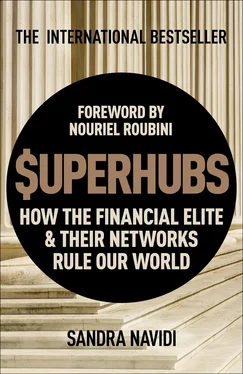Sandra Navidi - SuperHubs - How the Financial Elite and Their Networks Rule our World
Здесь есть возможность читать онлайн «Sandra Navidi - SuperHubs - How the Financial Elite and Their Networks Rule our World» весь текст электронной книги совершенно бесплатно (целиком полную версию без сокращений). В некоторых случаях можно слушать аудио, скачать через торрент в формате fb2 и присутствует краткое содержание. Год выпуска: 2017, Издательство: Hodder & Stoughton, Жанр: Старинная литература, на английском языке. Описание произведения, (предисловие) а так же отзывы посетителей доступны на портале библиотеки ЛибКат.
- Название:SuperHubs: How the Financial Elite and Their Networks Rule our World
- Автор:
- Издательство:Hodder & Stoughton
- Жанр:
- Год:2017
- ISBN:нет данных
- Рейтинг книги:4 / 5. Голосов: 1
-
Избранное:Добавить в избранное
- Отзывы:
-
Ваша оценка:
- 80
- 1
- 2
- 3
- 4
- 5
SuperHubs: How the Financial Elite and Their Networks Rule our World: краткое содержание, описание и аннотация
Предлагаем к чтению аннотацию, описание, краткое содержание или предисловие (зависит от того, что написал сам автор книги «SuperHubs: How the Financial Elite and Their Networks Rule our World»). Если вы не нашли необходимую информацию о книге — напишите в комментариях, мы постараемся отыскать её.
SuperHubs: How the Financial Elite and Their Networks Rule our World — читать онлайн бесплатно полную книгу (весь текст) целиком
Ниже представлен текст книги, разбитый по страницам. Система сохранения места последней прочитанной страницы, позволяет с удобством читать онлайн бесплатно книгу «SuperHubs: How the Financial Elite and Their Networks Rule our World», без необходимости каждый раз заново искать на чём Вы остановились. Поставьте закладку, и сможете в любой момент перейти на страницу, на которой закончили чтение.
Интервал:
Закладка:
POWER WORKOUT: NETWORKING, WORKING, AND WORKING OUT
Executives don’t just network over meals. They also belong to highly exclusive fitness clubs, such as Sitaras Fitness, where they can easily conduct business during a workout. From the outside, Sitaras Fitness is inconspicuous, without any nameplate to give away its presence. Yet dark limousines regularly pull up to the exclusive high-rise in Midtown Manhattan across from the futuristic Bloomberg Tower. As chauffeurs open the doors, investment legends such as George Soros, Jack Welch, James D. Robinson III, Paul Volcker, and numerous others emerge, clad in workout gear. Sitaras may have the highest concentration of financial top executives of any gym in the city. So exclusive is its clientele that it made the New York Times, the Financial Times, and various other international media.8 9 Especially in America, where athleticism is directly correlated with presumed vitality, dynamism, and a sharp mind, there is no alternative to working out—no matter how busy, athletically challenged, or age-advanced the executive. Fitness is a status symbol.
Founded by John Sitaras, a trainer and former bodybuilder, the private club accepts new members only by referral and after thorough background checks. Sitaras has perfected the art of the gym with his proprietary analysis program and individualized, personally administered exercise routines. Warm and personable, he has a natural gift of connecting with powerful personalities. With vision and unfailing instinct, he built relationships with a top clientele that doubles as his investors and advisers. In New York’s ultracompetitive environment, Sitaras differentiates himself by catering to a niche market that comprises some of the most demanding and difficult characters on the street. The superhubs enjoy the privacy and luxury, but most of all the privilege of each other’s company without being judged or bothered. In a city of more than 8 million people and a myriad of choices, these captains of industry are pulled into a force field of homogeneity where they feel comfortable and relaxed. As an ancillary benefit, they can casually discuss business and make deals while settling into the comfortable lounge chairs on the terrace, a lush oasis in the midst of the Midtown concrete desert. Word has it that major deals have originated there.
Although I am one of only a few women at Sitaras, just as on Wall Street, I feel comfortable there because of its private atmosphere and spacious duplex facilities. Of course, doing leg presses while Paul Volcker stretches next to you can be slightly awkward, but it makes for good banter next time you are seated next to each other at a formal dinner. For people who are on duty 24/7, there is no separation between networking, working, and working out.
“SUPERHUB-NOBBING”: PRIVATE PARTIES
George Soros’s Spanish Renaissance-style estate, El Mirador is located off the billionaire rows on Old Town Road in Southampton. The legendary investor spends the months of July and August there, with occasional trips to the city if need be. To some people, such mansions are visual manifestations of their success, others simply enjoy their beauty and luxury, but almost all use their homes as networking platforms where they entertain guests. The same applies to George Soros, who has built unbelievably intricate networks around the world. Every weekend he hosts a scheduled set of guests at El Mirador, usually an eclectic mix, which makes his social gatherings so interesting. If a group is too homogeneous, the conversation might lack stimulation, but if people are too different, it might lack a spark. The best combination is a mix of people who are already acquainted with a few new people. If temperaments complement one another, the conversation usually flows: Talkers are placed next to listeners, introverts mixed with extroverts, and funny people with more serious ones. Soros always puts together the right mix and also enjoys personally designing the seating chart. Artists, intellectuals, and financiers exchange views, argue, and joke in spirited conversations.
Guests are accommodated in comfortable quarters inside the main house or in the guesthouse complex, which is located in the beautiful garden amidst old trees, colorful flowerbeds, a pool, and a tennis court. The property is a three-minute walk from the beach, which Soros frequents after his tennis matches. The schedule is informal without a protocol, and guests are at liberty to spend their time as they please with the staff at their disposal. They can enjoy breakfast at their convenience and lunch in the vast gardens. The only formal events are the dinners. The evenings typically begin with cocktails on the front porch, which is a good time to mingle and engage with new acquaintances. After about an hour when the sun begins to set, the guests move on to the formal dining room, where stimulating discussions ensue. Soros’s guests are often dear friends and leaders in their respective fields, and all have something interesting to contribute. The exchange of dialogue with groups of highly diverse people is one way in which Soros stays on top of issues. Sometimes he tosses out ideas for discussion and receives feedback he might not have previously considered.
For the rest of the year and absent traveling, Soros spends his weekends in the country at his stately yet homey Bedford estate, which sits on a hilltop nestled in sweeping lush gardens with breathtaking views of the surrounding countryside. The house has a slew of guestrooms, each designed according to a different theme. He enjoys the company of serious thinkers, more often than not people with intellectual rather than material wealth. Because Soros is a superhub, over the years his friends have become one another’s friends. The diversity of people close to him reflects his diverse networks all over the world. Hosting private parties on their estates provides superhubs with yet another perfect networking platform to expand and strengthen their top positions.
THE HIGHER PURPOSE OF NETWORKING: THE CHARITY CIRCUIT
The financial elite have many opportunities to come together and network, but few events are a bigger draw than charities. Throughout the year, financiers rub elbows at various charity events all over the world. The most significant philanthropic galas—hosted by and for the elite—still take place in New York. Due to comparatively low taxes and a relatively weak social system, Americans traditionally have a more generous giving culture. Anglo-Saxon financiers are ideally positioned to optimize the efficiency of philanthropy by applying their financial and business savvy, a strategy that Matthew Bishop and Michael Green have coined “philan-throcapitalism.”10 For the wealthy, it is a social must to commit and give to a cause. This was how Bill Gates reeled in Warren Buffett and a few dozen other billionaires to join him in the “Giving Pledge” and donate at least half of their fortune to charitable causes. Many of them sit on the same boards of hospitals, museums, opera houses, ballet companies, and educational institutions, where they use their friendships and connections to attract donors and raise top dollars. The galas they host combine serious causes with lighthearted entertainment—replete with star wattage, glamour, and media exposure.
Since support is expected to be reciprocated, charitable contributions have skyrocketed. Despite falling significantly during the financial crisis, they have since recovered. Critics object that the engagement of billionaires in highly publicized charities is a self-celebratory endeavor. While it is true that philanthropy enhances their image, status, and probably happiness, self-serving motives cannot detract from charity’s effects, and in the end the benefits far outweigh any drawbacks.
Читать дальшеИнтервал:
Закладка:
Похожие книги на «SuperHubs: How the Financial Elite and Their Networks Rule our World»
Представляем Вашему вниманию похожие книги на «SuperHubs: How the Financial Elite and Their Networks Rule our World» списком для выбора. Мы отобрали схожую по названию и смыслу литературу в надежде предоставить читателям больше вариантов отыскать новые, интересные, ещё непрочитанные произведения.
Обсуждение, отзывы о книге «SuperHubs: How the Financial Elite and Their Networks Rule our World» и просто собственные мнения читателей. Оставьте ваши комментарии, напишите, что Вы думаете о произведении, его смысле или главных героях. Укажите что конкретно понравилось, а что нет, и почему Вы так считаете.












